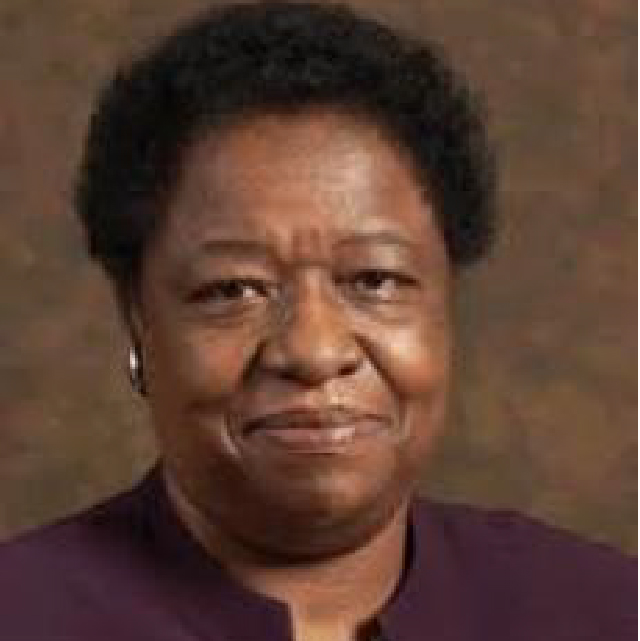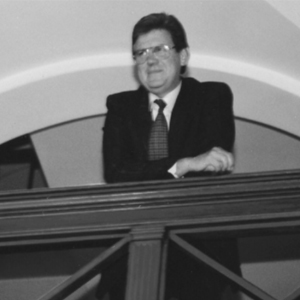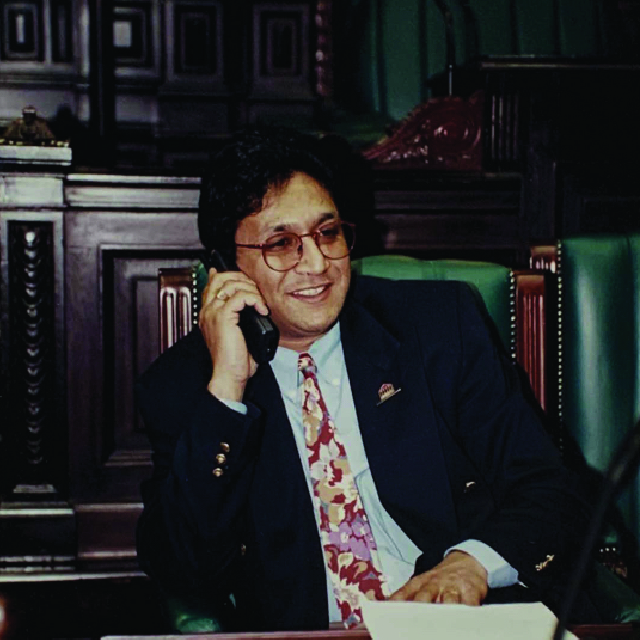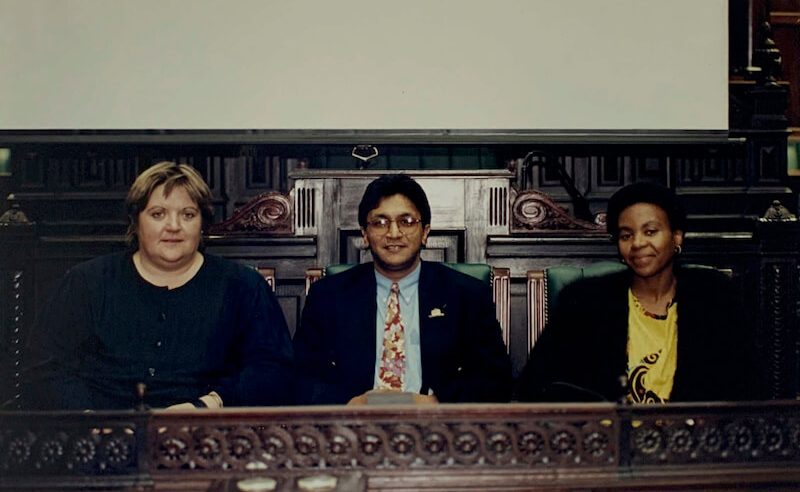Establishing THE
CONSTITUTIONAL ASSEMBLY
After South Africa’s first democratic elections, the newly elected parliament would double as a Constitutional Assembly and would be responsible for writing the final constitution. The Constitutional Assembly was given just two years to complete this mammoth task. It was agreed that the new text had to comply with the Constitutional Principles entrenched in the first stage of negotiations and that the Constitutional Court would then decide if the text complied with the Principles.
Thus, while the Interim Constitution was a politically negotiated product, the final Constitution was not. The final Constitution was produced through extensive public involvement facilitated by the first democratic parliament and led by Cyril Ramaphosa. Here, we look at the nitty-gritty of how the Constitutional Assembly got down to the business of building a solid foundation upon which to build a new country. We come to understand how many controversial issues kept the constitutional drafters battling until the very end. We see that the final Constitution was the outcome of a complex and rich process.
Navigate this section
Some of our storytellers

Cyril Ramaphosa

Brigitte MABANDLA

Leon Wessels

Mavivi Myakayaka-Manzini

NELSON MANDELA

HASSEN EBRAHIM

WILLIE HOFMEYR
The first democratic Parliament
On a sunny Monday, 9 May 1994, South Africa’s first democratic parliament met for its first sitting. The mood was joyous. After centuries of legalised white supremacy, the historic gathering of parliamentarians represented all political parties in the country, in accordance with the results of a non-racial election that had been declared ‘free and fair’. This new Parliament’s mandate was two-fold: to govern the new democracy and to draft a new Constitution in a
two-year time frame.
The government I have the honour to lead … is inspired by the single vision of creating a people-centred society … to the pursuit of the goals of freedom from want, freedom from hunger, freedom from deprivation, freedom from ignorance, freedom from suppression and freedom from fear.
President Nelson Mandela
First State Of The NAtion Address, 9 May 1994
It’s really a wonderful feeling to be sitting in the same chamber of Parliament that I have sat in since 1981 and to realise that the whole of South Africa is now represented here. It is a completely different place. There used to be a very stuffy sort of an atmosphere … Now the colourfulness of South Africa has come to the fore. Even though there are hitches and hiccups – we almost never start on time anymore – it’s a much better Parliament …
Piet Marais
Then National Party Member of The Constitutional Assembly
WHAT WAS THE CONSTITUTIONAL ASSEMBLY?
The 490 members of Parliament from seven different political parties, doubled up as the Constitutional Assembly (CA). The CA’s job was to draft the final Constitution. The CA was formed by two parts of the National Parliament – the National Assembly of 400 people and the Senate of 90 people.
The political parties were represented in the CA as follows:
African National Congress
Leader : Nelson Mandela
CA Members: 312
National Party
Leader : FW De Klerk
CA Members: 99
Inkatha Freedom Party
Leader : Mangosuthu Buthelezi
CA Members: 48
Freedom Front
Leader : Constand Viljoen
CA Members: 14
Democratic Party
Leader : Tony Leon
CA Members: 10
Pan Africanist Congress
Leader : Clarence Makwetu
CA Members: 5
African Christian Democratic Party
Leader : Kenneth Meshoe
CA Member: 2
The writing of a new Constitution for a democratic South Africa will no doubt stand out in history as one of the most important and abiding tasks in the transition of our country … the final Constitution must be as reflective of the wishes of all our people, as it will be durable…
Cyril Ramaphosa
then Chair of the Constitutional Assembly
I am convinced that the foundation for nation building was established during the period of the Constitutional Assembly. The CA became a vibrant forum for dialogue made up of people from all walks of life – many of whom never having engaged in serious matters such as constitutional principles and the socio-economic and multi-cultural challenges of our country.
Brigitte MABANDLA
then ANC member of the Constitutional Assembly
THE TIME FRAME
There had never been a process like this anywhere. When we started everybody said it was impossible to do it within two years.
Hassen Ebrahim
Then Executive Director of the Constitutional Assembly
At the first sitting, Mandela told the 490 members of the CA, who had the eyes of the world upon them: “Let us all get down to work!” Mandela then withdrew from the proceedings of the CA. He took no part in its meetings. As president of the country, his job was to sit back now, respect the separation of powers and leave it for the CA to draft the Constitution. He took no part in the deliberations. This was not Mandela’s constitution.
While all the business of Parliament continued normally in the National Assembly under the control of speaker, Frene Ginwala, passing new legislation in both houses, each of the political parties appointed individual MPs to the various committees of the CA according to their qualifications and experience. They became the constitutional drafters. During the first three months, however, members of the CA were engaged in the establishment of the first democratic Parliament and little work was accomplished in the CA itself.
Members of the CA are also elected political representatives responsible for the establishment of the democratic parliament, the government of national unity, a demanding legislative programme, attending to constituencies and, not least, preparations for the local government elections. This meant that structures of the CA were only able to operate on one day of the week during those periods when parliament was in session.
Constitutional Assembly Annual Report
May 1994 – May 1995
The constitution-making process should not be seen in isolation from the broader context. South Africa is in the midst of a reconstruction process. The work of the Constitutional Assembly is part of the broader reconstruction and democratisation process in our country.
Cyril Ramaphosa
Then Chair of the Constitutional Assembly
What Were the 34 Constitutional Principles?
The Constitution had to be negotiated within the framework of the 34 Constitutional Principles, negotiated at the Multi Party Negotiating Forum and enshrined in the Interim Constitution of 1993. The Principles dealt with a vast range of issues from having an entrenched, universally recognised Bill of Rights to the electoral system, the role of traditional leaders and the relationship between different spheres of government. The newly formed Constitutional Court was given the unprecedented authority to determine whether the Constitutional Assembly had complied with the 34 Principles in drafting the final Constitution. If the Court decided that they did not comply, it could refer the text back to the CA for revision. The Principles were a summary of the spirit of the still-to-be-born new Constitution and emphasised broad consensus positions that encouraged unity and nation building. None of Principles dealt directly with property rights, or the rights of employers to lock-out, which were to become sticking points later on in the CA process. The 34 Principles were binding. They couldn’t be scrapped or changed by the CA, not even by a two-thirds majority. The 34 Principles were an annexure in the Interim Constitution (Schedule 4) which became law on 27 April 1994.
Initially, there were 33 Principles agreed to. The 34th Principle dealing with the right to self-determination by particular communities was added later.
How was the Constitutional Assembly Structured?
Select a block to learn more
CONSTITUTIONAL ASSEMBLY
400 FROM THE NATIONAL ASSEMBLY
90 FROM THE SENATE
CONSTITUTIONAL COMMITTEE
PANEL OF INDEPENDENT CONSTITUTIONAL EXPERTS
MANAGEMENT COMMITTEE
ADMINISTRATION
Theme committees
The Management and Constitutional Committees were supported by six individually themed parliamentary committees. Each of them comprised 30 members drawn from all political parties in proportion to their representation in Parliament. The Theme Committees met weekly and were presided over by three Chairpersons on a rotational basis. The Committees began their work in September 1994.
The main function of the Theme Committees was to ensure the inclusive nature of the constitution-making process by receiving views and ideas, calling for submissions from political parties, civil society and the broader public. The committees then processed these in the form of reports on sections of
the new Constitution.
It will be their task to isolate these views, to find common ground where that is possible and to process key issues.
Pravin Gordhan
then ANC member of the Constitutional Assembly
The first substantive reports from the Theme Committees were tabled before the Constitutional Committee in February 1995. Each Theme Committee was supported and advised by a Technical Committee made up of constitutional lawyers and other experts – who supported and advised the politicians. They assisted in the drafting of the Theme Committee reports that went to the Constitutional Committee.
Who were the constitutional drafters?
The drafters of the Constitution came from opposing political parties and shared different visions of the end result. But from the outset, they were united by a strong will to get the job done. They understood that the Interim Constitution was a reference document and that the 34 Constitutional Principles enshrined in it were ‘the fundamental guidelines, the prescribed boundaries’ within which they had to fulfill their drafting function. Their ultimate mandate, however, was to write a constitution ‘from scratch’ and to consult with the people of the country in so doing. The new text had to be both ‘legitimate and enduring’ – the result of a process deemed credible and accepted by all.
Led by the newly elected Chairperson of the Constitutional Assembly, Cyril Ramaphosa, and his deputy, Leon Wessels, they set out on their daunting mission with a great spirit of co-operation.
I am a great optimist. We will meet the deadline.
Cyril Ramaphosa
There is tough political bargaining ahead, but I hope intellectual balance, good humour and farsightedness will be shown.
Cyril Ramaphosa
Ramaphosa set the tone for the next 24 months with his first words after receiving a standing ovation in Parliament.
They call me the Chairperson of the Constitutional Assembly. I make tea for everyone. I clean up the room when they’ve messed it up after meetings, so I do a very menial job in this place.
Cyril Ramaphosa
When asked by television interviewers about his role in the
Constitutional Assembly
At Kempton Park … we had to focus on breaking the political deadlock that had polarised the country. We had to deal with the question of the transition from one order to another. That was essentially a political settlement we were crafting. Here, we will not be dealing with transitional matters. We are dealing with a constitution that will stand the test of time and take us into the 21st century.
LEON WESSELs
Then Deputy Chair of the Constitutional Assembly
Constitution drafters reflect:
I am convinced that it was during constitutional negotiations that we learnt to work together, to be tolerant and less angry, to seek consensus and to put South Africa first. Today we can talk of shared values, affirming that we are a constitutional state.
Brigitte MABANDLA
then ANC member of the Constitutional Assembly
It was through dialogue that we as South Africans succeeded within two years to create our Constitution. We learnt that we had to listen to different viewpoints and to be politically tolerant. We did not have to agree on everything, but we had to learn to compromise by pushing our country and its people first.
Mavivi Myakayaka-Manzini
then ANC member of the Constitutional Assembly
It was all hands on deck during the difficult and often contentious negotiations that took place in the Old Assembly Chamber. In the process, I gained valuable experience in negotiating … And that, in the thorny months that followed, was what we had to do: talk to the enemy, eat with the enemy and drink with the enemy, until suddenly they were not the enemy any longer, but real people with concerns and positions that we came to understand.
Willie Hofmeyr
then ANC member of the Constitutional Assembly
Achieving agreement on the basics of the constitution
The extraordinary number of hours being put in by the different Theme Committees was producing large areas of agreement amongst the drafters and resulting in the spinal column of what is today South Africa’s Constitution. Agreement was reached in four major respects: values, structures of government, equality and redressing imbalances created by apartheid and unity in diversity.
Audio Visual
The graphics used in this component are drawn from the following sources:
Constitutional Assembly Publication, You and the Constitution, 1995.
Constitutional Assembly Publication, Constitutional Talk, Volume 9, 1995.
The quotes used in this component are drawn from the following sources:
Constitutional Assembly Annual Report, May 1994 – May 1995
Christina Murray, A Constitutional Beginning: Making South Africa’s Final Constitution, 23 U. Ark. Little Rock L. Rev. 809 (2001).
Available at: http://lawrepository.ualr.edu/lawreview/vol23/iss3
Mike Nicol, The Making of the Constitution
Parliament of the Republic of South Africa (2018) Theme Committee Book Series 1-6





